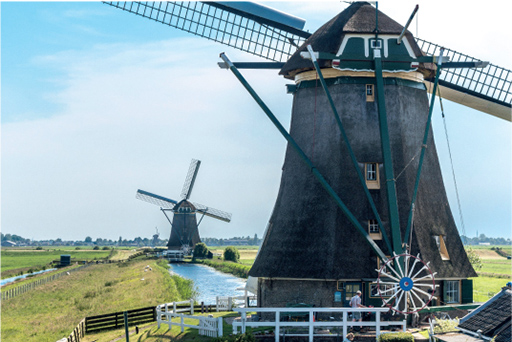1.2 Flood risk management
Throughout history, humans have employed measures to manage or protect themselves from flooding. These can be divided into measures that try to keep the water out and those that aim to make space for water using of the land around rivers, lakes, reservoirs and so on as ‘catchment areas’ to take up and contain the flood water.
One of the most longstanding systems to keep water out is the example of the Dutch polders. A polder is land that is at or below sea level. Water is kept out by a system of dykes and dams, with water that seeps in under the dykes being pumped out into a system of canals and rivers. In the Netherlands, pumping was traditionally done using wind power, hence windmills being a feature of the Dutch landscape. Dutch engineers became renowned for their flood risk skills. They were hired in the 1600s to work on the drainage of the Fens in eastern England and, in this century, have helped countries like Bangladesh to build flood defences (The Construction Index, 2015). Dykes (also called levees) and dams are used across the globe, including, for example, New Orleans in the US and a massive dam complex across the Neva Bay, completed in 2011, to protect the city of St Petersburg in Russia. Another iconic dam is the Thames Barrier, in operation since 1982, which can be raised to protect London from flooding due to storm surges along the river from the North Sea.
Keeping water out through massive engineering projects like these has been a popular option, but is costly. Moreover, in the face of rising sea levels and changing weather patterns due to global warming there is no guarantee that existing dykes and dams will not be breached in future, making the need for further investment likely (Kozin, 2019; Lineback and Gritzner, 2014).
Activity 2 Making Space for Water
Watch Video 1 and think about how a policy of making space for water differs from the idea of keeping water out. Take notes of the arguments that this approach is an improvement on previous understandings of flood risk management, but also consider if there are groups that might find the new approach less effective than the old.
1. What does the ‘making space for water’ approach advise?
Answer
Making space for water means slowing down the flow of rivers by building wider courses, allowing rivers to meander, and ensuring traditional flood lands or less vulnerable areas are able to take flood water. It also encourages land use that helps manage water, like alluvial forests (in other words, forests growing in the fertile soil deposited by flood water). Key to this approach is thinking about the whole catchment area for water rather than focusing simply on individual cities or inhabited areas, without considering how action taken in one place affects those upstream or downstream.
2. What benefits does a catchment approach to water have?
Answer
Since rivers flow more slowly, flooding is less likely and the flooding happens in more predictable areas. Allowing natural processes to determine how water moves through the environment makes it easier to control. The video gives a good sense of how trying to build walls to keep water out of residential and urban areas may do more harm than good. If rivers are encouraged to run through narrow courses with concrete embankments, they may flow too fast for containment after heavy weather and cause more flooding than if wider channels with natural banks are allowed for them, with concrete embankments only to prevent overflow in heavy weather. This approach also entails reconnecting rivers with their natural floodplains further upstream, allowing them to flow in their old channels and ensuring less vulnerable land is available to flood when needed.

